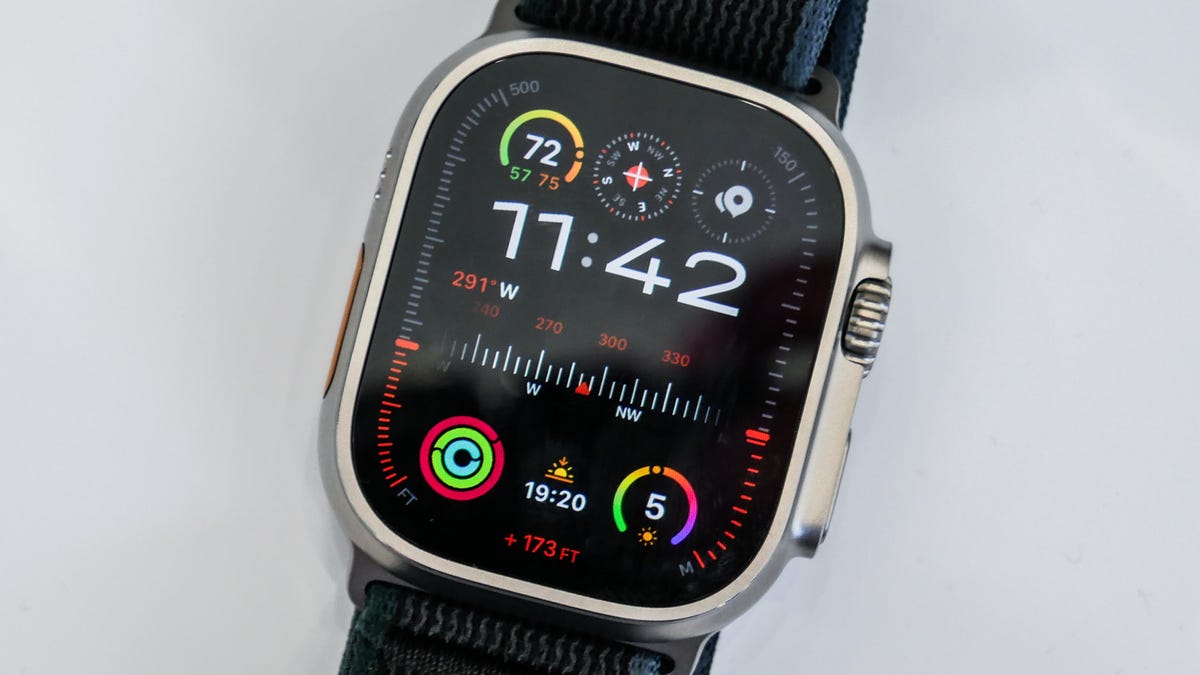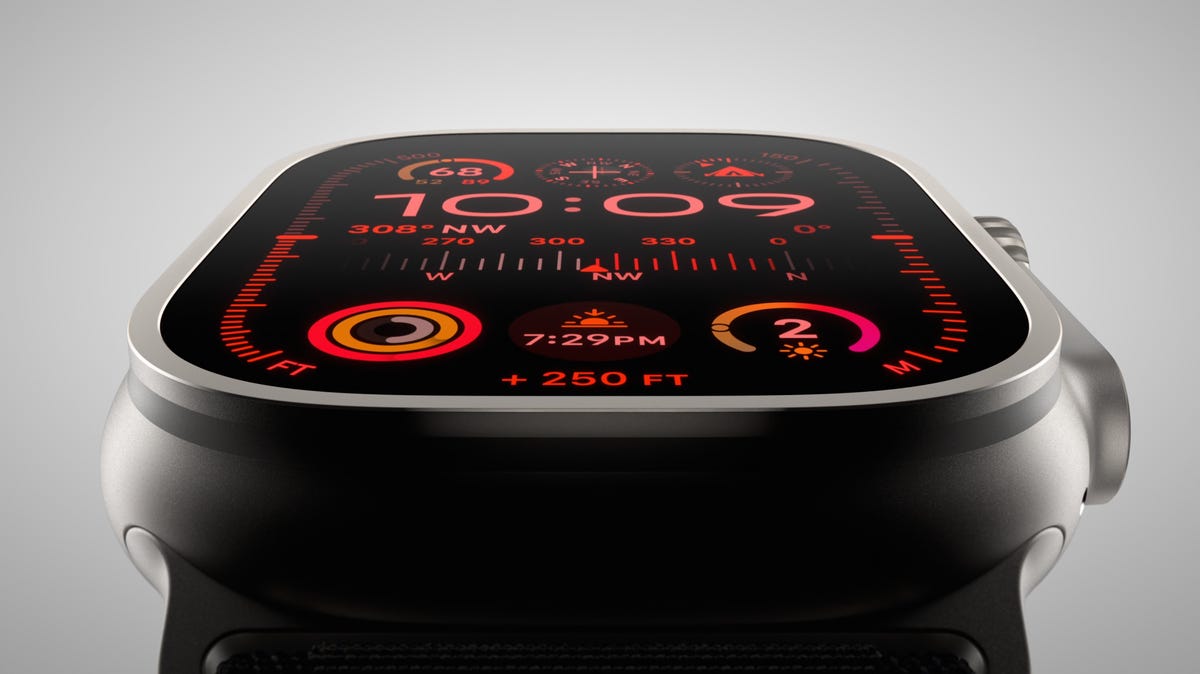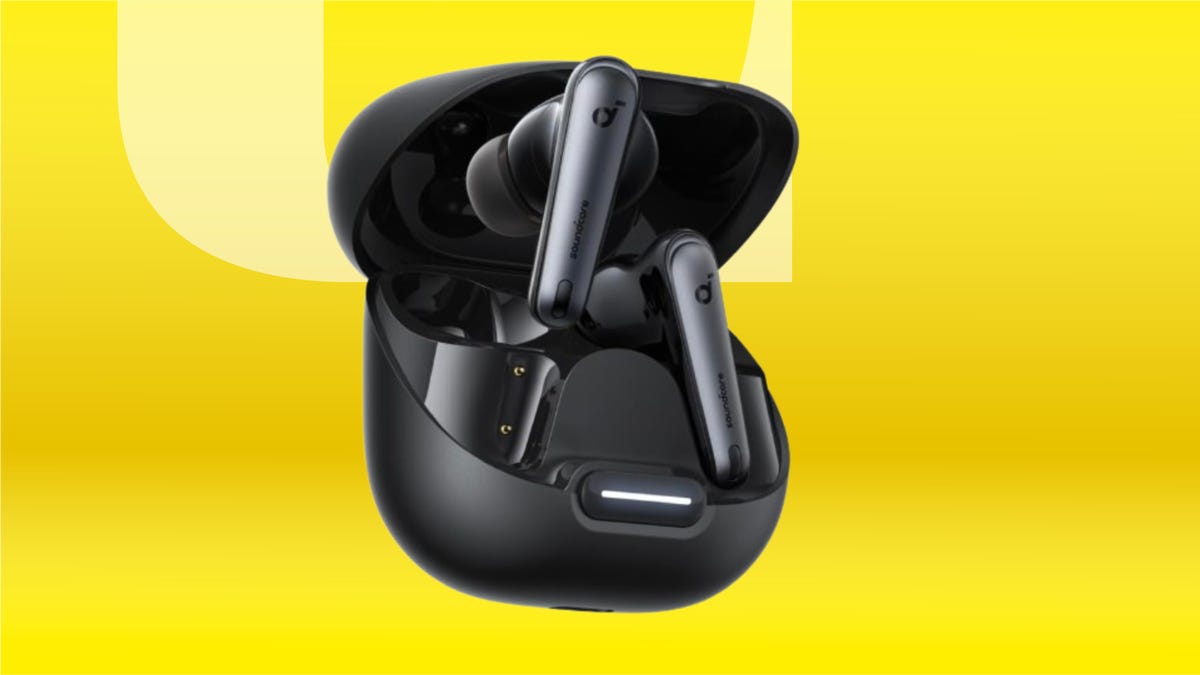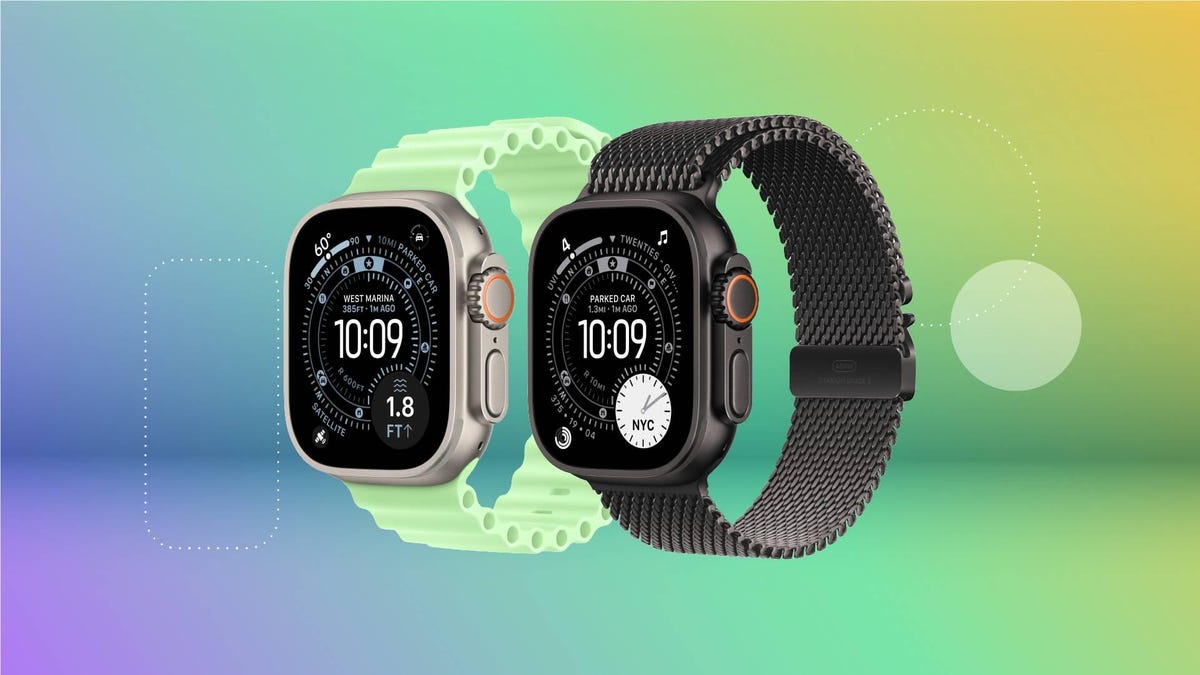Technologies
Apple Watch Ultra 2 Hands-On: It’s All About That Bright Screen
The Apple Watch Ultra 2 has a new screen. And it’s really, really bright.

At a glance, the $799 Apple Watch Ultra 2 might pass for the first-generation Ultra if you see it on someone’s wrist. It’s the same 49mm size, and the case is also made from titanium. But its screen maxes out at an eye-watering 3,000 nits which makes it the brightest screen of any Apple Watch. Announced alongside the Apple Watch Series 9, the Ultra 2 is Apple’s second high-end outdoor watch and it arrives Sept. 22.
It’s an evolution of last year’s Apple Watch Ultra, which I called the most exciting watch in years. After some brief hands-on time with the Ultra 2 at Apple Park, I’m most impressed by the screen and new features like Double Tap that let you control the watch with a simple pinch gesture. There are a few more tools on the Ultra 2 for sports enthusiasts too, but doesn’t necessarily warrant upgrading from the first-generation Ultra.
The original Apple Watch Ultra, also $799, was Apple’s take on an adventure watch to compete with the likes of Garmin. It’s aimed at a wide range of sports enthusiasts, with special features for scuba divers and hikers, to name a couple. But the Ultra also appeals to anyone who wants an Apple Watch with the biggest screen and longest-lasting battery — that still holds true for the Ultra 2.
A brighter screen and new Modular Ultra watch face
The Ultra 2 pushes the maximum screen brightness to 3,000 nits, a significant increase from the original Ultra that featured a 2,000-nit display. This should make it even easier to see in bright, outdoor situations like in the snow or in sunlight. I found the easiest way to see the brightness boost was activating the flashlight from the Control Center to see the difference from the first-gen Ultra.
The Ultra 2 also has an exclusive new watch face called Modular Ultra, which uses the edge of the display to show more details like altitude, depth or seconds. I found slots for at least seven complications in my brief hands-on time with the Ultra 2 so you can really tune this watch face to your needs.
Night mode activates automatically when the light is low enough by using the ambient light sensor, which is a feature that also comes to the Wayfinder watch face on the first-gen Ultra if you are running WatchOS 10. Apple has added the second-generation ultrawideband chip that supports precision finding for the iPhone 15.
More from the Apple event

Double Tap and Siri improvements
Shared with the Series 9 is Double Tap, a pinch gesture that you can use to control the watch. For instance, you can tap your thumb and forefinger together to answer a call. It accomplishes this via the accelerometer, gyroscope and heart-rate sensor. Sound familiar? It builds on the work Apple has done with AssistiveTouch, which allows for greater accessibility through gestures, but it is separate.
Double Tap is active by default and how it works changes depending on context. I was able to raise my wrist to see the time, then double tap to bring up the smart stack, or widgets, found in WatchOS 10. Double tap again and I was scrolling through the widgets. Open the timer app and I could start or stop the countdown with a double tap. You’ll be able to answer calls with the same gesture.
This is one of the features supported by the new S9 chip, the same as the Series 9 uses. It also powers the on-device Siri, which promises more accurate dictation. You’ll also be able to ask Siri to give you an update on your health metrics, like asking how much sleep you got the previous night.

More Cycling tools and extended altitude range
Shipping with the new WatchOS 10 software, the Ultra 2 will also offer more tools for cyclists, including pairing with Bluetooth devices like power meter pedals. You’ll also be able to see your cycling metrics on the iPhone screen thanks to Live Activities. I’ve been testing out these features over the past couple months in the public beta of WatchOS 10 with the original Ultra and as a cyclist, find them really helpful.
The Ultra 2 also has a wider altitude range, from 500 meters underwater to 9,000 meters above ground. Updates to the Depth app now log your sessions so you can review them on the watch or iPhone, plus the Oceanic Plus app from Huish Outdoors now supports freediving.
Apple also upped the amount of recycled materials in the case, from all-virgin titanium on the first-generation Ultra to 95% recycled titanium on the Ultra 2. Battery life stays the same as the original Ultra, rated for 36 hours with regular use and up to 72 hours in low-power mode.
Apple now has three watches in its lineup:
- The $249 (£219, AU$399) second-generation Apple Watch SE, released in 2022
- The $399 (£399, AU$649) Apple Watch Series 9
- The $799 (£799, AU$1,399) second-generation Apple Watch Ultra
Technologies
These Anker Earbuds Are Down to $57 — and Even Amazon Couldn’t Resist Matching the Price
Grab yourself a solid pair of earphones that offer excellent noise cancellation and battery life.

There are plenty of earbud options out there, but finding the right ones for you can feel nearly impossible as a result. But if you’re after some of the best noise-canceling wireless earbuds and you’d like to save some money, we might have the answer for you.
Best Buy is running a one-day sale on the excellent Anker Soundcore Liberty 4 NC earbuds, knocking the price to just $57 — which matches the lowest price we’ve seen yet. And Amazon’s price-matching. With a 43% discount, now’s the time to grab a pair before this limited-time deal disappears.
These earbuds have 11mm drivers, as well as hi-res wireless, LDAC technology and adaptive noise canceling that should reduce noise from your environment by up to 98.5%, according to Anker. That means you can stay immersed in the music (or other content you love) regardless of what’s going on around you.
Plus, because they’re equipped with six mics, they offer good call quality, regardless of your environment. We found them comfortable, too, and loved the bass they put out.
Hey, did you know? CNET Deals texts are free, easy and save you money.
The Liberty 4 NC earbuds have an impressive battery life as well, offering up to 10 hours of playback per charge, with an additional 50 hours available with the charging case. And just 10 minutes of fast charging can get you up to four hours of playback. They’re also rated IPX4 water-resistant, so any inclement weather while you’re out shouldn’t cause these buds any harm.
Another great feature these earbuds offer is multipoint connection, which lets you connect to your phone and your computer at once, which is super convenient. That’s a lot of features for earbuds this affordable.
If you’re not totally sold on this model, be sure to check out our roundup of all the best headphone and earbuds deals happening now.
HEADPHONE DEALS OF THE WEEK
-
$300 (save $51)
-
$299 (save $151)
-
$220 (save $180)
Why this deal matters
These excellent earbuds are now available at their record-low price. Best Buy is limiting this discount to a one-day sale, and we expect Amazon to end the deal around the same time, so be sure to grab a pair before this opportunity expires.
Join Our Daily Deals Text Group!
Get hand-picked deals from CNET shopping experts straight to your phone.
By signing up, you confirm you are 16+ and agree to receive recurring marketing messages at the phone number provided. Consent is not a condition of purchase. Reply STOP to unsubscribe. Msg & data rates may apply. View our Privacy Policy and Terms of Use.
Technologies
The Apple Watch Ultra 3 Just Got Its First Proper Discount, but It Won’t Last Long
The latest rugged smartwatch from Apple is yours for just $700 right now.

The Apple Watch Ultra 3 has only been on sale for a few weeks, but it’s already available for its first real discount. Getting one of the best smartwatches money can buy isn’t going to be cheap, but this deal saves you $99 off the usual asking price. But be warned, we don’t expect this early Black Friday deal to last long.
The result? You’ll pay just $700 for your new Apple Watch Ultra 3, with a couple of colors and band combinations available. These prices often fluctuate, so we suggest checking out all available pairings before placing your order. Apple Watch Ultra 3 deals are likely to come and go quickly.
All Apple Watch Ultra 3 models come with cellular modems inside so you can connect them to your carrier — assuming it supports the Apple Watch’s eSIM. That’ll allow you to stay connected even when you don’t have your iPhone with you.
Hey, did you know? CNET Deals texts are free, easy and save you money.
The Apple Watch Ultra 3 comes in a large 49mm size, so it’s easy to read. Despite that huge display, Apple Watch Ultra 3 owners can expect long-lasting battery life. In fact, the Apple Watch Ultra 3 can run for up to 42 hours in normal mode and a whopping 72 hours in its low-power mode.
This being an Apple Watch, it comes with all of the usual health and fitness monitoring features, as well as sleep tracking. It can monitor your heart rate, track your progress thanks to its precise dual-frequency GPS, and do a whole lot more.
If the standard Apple Watch models can’t quite live up to your busy, active lifestyle, this is the model for you. Be sure to order your new smartwatch before this deal expires.
SMARTWATCH DEALS OF THE WEEK
-
$329 (save $100)
-
$200 (save $100)
-
$200 (save $100)
-
$500 (save $150)
Why this deal matters
The latest Apple Watch Ultra 3 is the best of its kind. It has a new display that’s designed to be easier to read and has an impressive battery life. It isn’t the cheapest smartwatch on the market, but if you want the best that Apple has to offer, now is the time to place your order — before this deal ends.
Looking for savings on other models? Check out all the best Apple Watch deals happening now.
Join Our Daily Deals Text Group!
Get hand-picked deals from CNET shopping experts straight to your phone.
By signing up, you confirm you are 16+ and agree to receive recurring marketing messages at the phone number provided. Consent is not a condition of purchase. Reply STOP to unsubscribe. Msg & data rates may apply. View our Privacy Policy and Terms of Use.
Technologies
Here’s the Best Time to Spot November’s Supermoon, the Brightest Moon of 2025
Does the moon look brighter and bigger? It’s not just you — here’s why this month’s supermoon is even more super.

November is a great month for skygazers, featuring a trio of meteor showers and the return of the northern hemisphere winter constellations. This week, it also features the second of four consecutive supermoons. This month’s supermoon will happen on Nov. 4-5, and November’s beaver moon is special because it’ll be the brightest full moon of 2025.
Don’t miss any of our unbiased tech content and lab-based reviews. Add CNET as a preferred Google source.
In addition to being a supermoon, November’s full moon is known as the beaver moon. There is some debate as to why it was named this way. Some believe that this was the best time of year in the old days to set beaver traps to get pelts for winter clothing. Others believe that it coincides with the busiest part of the year for beavers, who are now stocking their lodges with supplies for the upcoming winter.
The brightest supermoon: When’s the best time to see it?
The moon will reach peak illumination at 8:19 a.m. ET on Nov. 5, making the evening of Nov. 4 and the morning of Nov. 5 the best times to view the moon.
Since moon phases shift slowly, the moon will appear almost full for nearly a week. If you are unable to view the full moon on its best night due to weather or other reasons, you can still see a mostly full moon at any point from Nov. 3 to Nov. 8.
For all of those days, the moon will be measurably brighter in the night sky compared to any other full moon in 2025. The reason for this is because of the moon’s elliptical orbit. Since it’s not a perfect circle, the moon’s 27.3-day journey around the Earth brings it closer to us on some days, a phenomenon known as perigee. If there is a full moon during this time, it’s branded as a «perigean full moon,» which you may know better as a supermoon.
Not all supermoons are equal, and November’s will be a little more special than others. According to The Farmer’s Almanac, the beaver moon will be a scant 221,817 miles away from Earth, making it the closest full moon of the year. That means it’ll be the biggest and brightest of the year.
In practice, the differences are fairly minor and likely won’t be visible to the naked eye when compared side by side to other supermoons. A supermoon is only about 7% larger than a regular full moon. According to NASA, the biggest difference is when comparing a supermoon to a micromoon, where a supermoon will be about 14% larger and 30% brighter. So, if you notice that your backyard patio is lit up more than usual, it’s because of the supermoon.
Also due to the moon’s orbit, November will also bring a micro new moon, which means the moon will be as far away from the Earth as it can get — a phenomenon known as apogee. November’s new moon occurs on Nov. 20, but you won’t be able to see it.
-

 Technologies3 года ago
Technologies3 года agoTech Companies Need to Be Held Accountable for Security, Experts Say
-

 Technologies3 года ago
Technologies3 года agoBest Handheld Game Console in 2023
-

 Technologies3 года ago
Technologies3 года agoTighten Up Your VR Game With the Best Head Straps for Quest 2
-

 Technologies4 года ago
Technologies4 года agoVerum, Wickr and Threema: next generation secured messengers
-

 Technologies4 года ago
Technologies4 года agoBlack Friday 2021: The best deals on TVs, headphones, kitchenware, and more
-

 Technologies4 года ago
Technologies4 года agoGoogle to require vaccinations as Silicon Valley rethinks return-to-office policies
-

 Technologies4 года ago
Technologies4 года agoOlivia Harlan Dekker for Verum Messenger
-

 Technologies4 года ago
Technologies4 года agoiPhone 13 event: How to watch Apple’s big announcement tomorrow
